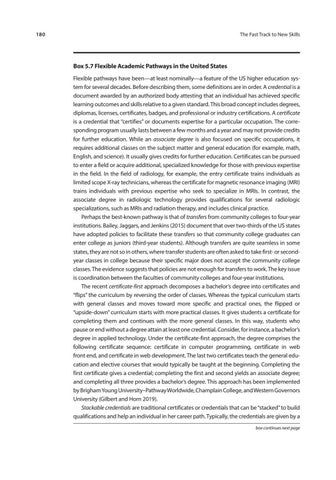180
The Fast Track to New Skills
Box 5.7 Flexible Academic Pathways in the United States Flexible pathways have been—at least nominally—a feature of the US higher education system for several decades. Before describing them, some definitions are in order. A credential is a document awarded by an authorized body attesting that an individual has achieved specific learning outcomes and skills relative to a given standard. This broad concept includes degrees, diplomas, licenses, certificates, badges, and professional or industry certifications. A certificate is a credential that “certifies” or documents expertise for a particular occupation. The corresponding program usually lasts between a few months and a year and may not provide credits for further education. While an associate degree is also focused on specific occupations, it requires additional classes on the subject matter and general education (for example, math, English, and science). It usually gives credits for further education. Certificates can be pursued to enter a field or acquire additional, specialized knowledge for those with previous expertise in the field. In the field of radiology, for example, the entry certificate trains individuals as limited scope X-ray technicians, whereas the certificate for magnetic resonance imaging (MRI) trains individuals with previous expertise who seek to specialize in MRIs. In contrast, the associate degree in radiologic technology provides qualifications for several radiologic specializations, such as MRIs and radiation therapy, and includes clinical practice. Perhaps the best-known pathway is that of transfers from community colleges to four-year institutions. Bailey, Jaggars, and Jenkins (2015) document that over two-thirds of the US states have adopted policies to facilitate these transfers so that community college graduates can enter college as juniors (third-year students). Although transfers are quite seamless in some states, they are not so in others, where transfer students are often asked to take first- or secondyear classes in college because their specific major does not accept the community college classes. The evidence suggests that policies are not enough for transfers to work. The key issue is coordination between the faculties of community colleges and four-year institutions. The recent certificate-first approach decomposes a bachelor’s degree into certificates and “flips” the curriculum by reversing the order of classes. Whereas the typical curriculum starts with general classes and moves toward more specific and practical ones, the flipped or “upside-down” curriculum starts with more practical classes. It gives students a certificate for completing them and continues with the more general classes. In this way, students who pause or end without a degree attain at least one credential. Consider, for instance, a bachelor’s degree in applied technology. Under the certificate-first approach, the degree comprises the following certificate sequence: certificate in computer programming, certificate in web front end, and certificate in web development. The last two certificates teach the general education and elective courses that would typically be taught at the beginning. Completing the first certificate gives a credential; completing the first and second yields an associate degree; and completing all three provides a bachelor’s degree. This approach has been implemented by Brigham Young University–Pathway Worldwide, Champlain College, and Western Governors University (Gilbert and Horn 2019). Stackable credentials are traditional certificates or credentials that can be “stacked” to build qualifications and help an individual in her career path. Typically, the credentials are given by a box continues next page

